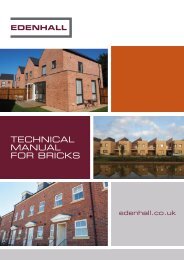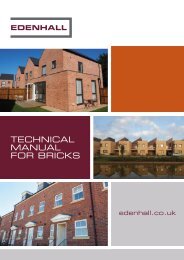You also want an ePaper? Increase the reach of your titles
YUMPU automatically turns print PDFs into web optimized ePapers that Google loves.
edenhall.co.uk<br />
7.2 Efflorescence & Colour Integrity<br />
The majority of <strong>Edenhall</strong> bricks are manufactured using crushed aggregates and stable synthetic pigments, all<br />
of which are predominantly insoluble, therefore the amount of soluble salts is minimal. There is no requirement<br />
within the British Standard to declare soluble salt content and therefore the bricks can be classed as having nilminimum<br />
efflorescence.<br />
Note: Further information on Efflorescence and Colour Stability is detailed in Brick <strong>Technical</strong> Bulletin<br />
BTB 7.<br />
7.3 Sulphate Resistance<br />
<strong>Edenhall</strong>’s dense bricks, due to their cement content, density and low absorption, are suitable for use in up to<br />
Class 2 ground sulphate levels. Higher sulphate conditions than this may necessitate a modification to the mix<br />
design. Engineering Quality bricks are made specifically for these locations and are suitable for Class 3 levels as<br />
well as use in sewerage conditions. (Ref. BTB 11).<br />
7.4 Water Absorption and Weathering Resistance<br />
The standard for concrete masonry indicates a moisture absorption by capillary test and results for individual<br />
brick types are given in Section 6.4. This test has superseded the more traditional 24 hour water absorption<br />
test, the results of which are also shown in the individual Brick <strong>Technical</strong> Data Sheets.<br />
The water absorption test approach is different for concrete bricks compared with that of clay bricks for example,<br />
but the requirements are there for different reasons. For clay bricks the test is primarily related to mortar adhesion<br />
and frost resistance, the former being important in case of excessive suction of the water from the mortar before<br />
it has had chance to cure, and the latter to ensure that the correct choice of brick is used in exposed conditions.<br />
A high absorption clay brick may be more susceptible to frost attack.<br />
With concrete bricks a low/medium absorption is important to inhibit the absorption of surface dirt whilst at the<br />
same time giving sufficient suction to allow the mortar bond to develop properly. <strong>Edenhall</strong> bricks are unique in<br />
that although some may contain an element of internal additives, others have a material applied to the face which<br />
contributes to maintaining the continuous appearance of the bricks. In addition the continuous ageing means the<br />
absorption reduces over the years whilst the bricks continue to develop in strength.<br />
7.5 Resistance to Rain Penetration<br />
<strong>Edenhall</strong> bricks have been independently tested in built wall conditions which showed that properly constructed<br />
walls adequately resist rain penetration. It should be noted that no bricks of any type will resist rain penetration in<br />
single leaf walls in prevailing conditions.<br />
Further information on Resistance to Rain Penetration is detailed in Brick <strong>Technical</strong> Bulletin BTB 9.<br />
27







